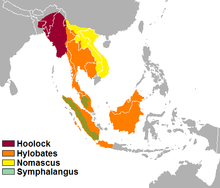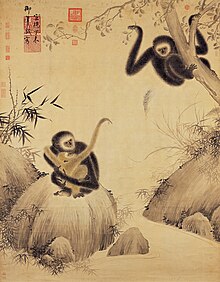Gibbons
| Gibbons | ||||||||||||
|---|---|---|---|---|---|---|---|---|---|---|---|---|

White-handed gibbon ( Hylobates lar ) |
||||||||||||
| Systematics | ||||||||||||
|
||||||||||||
| Scientific name | ||||||||||||
| Hylobatidae | ||||||||||||
| Gray , 1871 |
The gibbons (Hylobatidae) are a family of tree-dwelling primates from Southeast Asia . They are the sister group of the (Great) apes (hominids) and are therefore also called lesser apes called. There are 20 types.
distribution
Gibbons are found in Southeast Asia , their range extends from northeast India , Myanmar and southern China through Indochina and the Malay Peninsula to the Indonesian islands of Borneo and Java . In earlier times gibbons were more common; in the first half of the 2nd millennium, for example, they were found in much of China.
description
Gibbons are tailless primates. It is noticeable that the front limbs are much longer than the rear. This enables them to use the unique form of locomotion in the animal kingdom, the swinging swing (brachiation). Your thumb is rooted near the wrist, allowing a secure grip around the branches. Their thick fur is black, gray or brown in color, their snouts are short and their large eyes are directed forward. The dental formula corresponds with 2-1-2-3 of the apes . Some species have a throat pouch that serves as a sound box when they emit their loud cries. Gibbons reach a head body length of 45 to 90 cm and a weight of 4 to 13 kg, whereby the Siamang is by far the largest and heaviest species.
Way of life
The name Hylobates (ὑλοβάτης) literally means "forest walker" ( ancient Greek ὕλη hýlē "forest", βαίνω baínō , "I walk, wander, run around"). Gibbons are diurnal forest dwellers who, with their long arms and thumbs that are set far below, are perfectly adapted to the lean way of life. You swing through the trees and can cover 3 m with a single swing. On the floor they move forward on two legs ( bipedia ), with their arms stretched high in the air for reasons of balance. Their distribution area is primarily tropical rainforests , sometimes they also occur in mountain forests up to 1800 m altitude.
Gibbons live monogamous . A couple and their offspring live in a territory that they defend against intruders. Occasionally one finds solitary animals, mostly young adults, who had to leave their families. When looking for their own partner, young animals leave their parents or are chased away by them by force. The search for a suitable partner can take several years. In some species, the parents support their offspring by “reserving” a free area for them.
Gibbons are strictly territorial, the territory of a couple is between 25 and 50 hectares. They use preferred hiking routes in their territory. There are seldom fights with intruders, rather they try to defend their territory by screaming or threatening gestures (hopping or breaking off branches). Because of their strong ties to their territory, they do not simply wander away even after severe disturbances. This makes them particularly vulnerable to habitat destruction.
Gibbons have a large repertoire of sounds and, reinforced by the throat pouch, an impressive song is often performed. The chants are species-specific and mostly different in males and females. All types of gibbons except Hylobates moloch and H. klossii can sing in a duet (i.e. alternately). Males and females each sing different verses and coordinate their calls according to fixed rules. The duets are usually performed in the early morning, with different types at different times.
nutrition
Gibbons feed mainly on plants and rarely eat carnal food. Fruits make up 44 to 72% (on average 65%) of the diet, leaves 3 to 45% (on average 30%). Animal food only makes up a very small proportion on average (0 to 25%).
Since their main food, fruits, ripen in different seasons, gibbons can find and use this food throughout the annual cycle. Mostly they eat ripe fruit. Gibbons spend around 9 to 10 hours a day foraging for food. Depending on the proportion of leaves in the food spectrum of the species in question, the molars are more or less extensive in order to adequately chew this food. The voluminous caecum and colon with the single-chambered stomach are able to digest the leaf content in their food.
Due to their diet, they are more likely to compete with birds and squirrels than with other primates.
Reproduction
There shouldn't be a fixed mating season for the gibbons . Every two to three years the female gives birth to a single young animal, twin births are rare. The newborn clings as an active supporting Ling first at the mother's abdomen, later, the father involved in its cultivation. Young gibbons are not completely weaned until they are one and a half to two years old, and sexual maturity occurs between eight and nine years of age. Their life expectancy in the wild is likely to be around 25 years. In zoos, individual gibbons have become significantly older, more than 40 years have been documented.
Systematics
The Gibbons form the sister group to the apes (Hominidae)
They are divided into four genera with a total of 20 species:
- Genus Symphalangus
- Siamang ( S. syndactylus )
- Genus crested gibbons ( Nomascus )
- Western black crested gibbon ( N. concolor )
- Eastern black crested gibbon ( N. nasutus )
- Hainan crested gibbon ( N. hainanus )
- Northern white-cheeked crested gibbon ( N. leucogenys )
- Southern white-cheeked crested gibbon ( N. siki )
- Northern yellow-cheeked crested gibbon ( N. annamensis )
- Southern yellow-cheeked gibbon ( N. gabriellae )
- Genus White- browed Gibbons ( Hoolock )
- Western white-browed gibbon ( H. hoolock )
- Eastern white-browed gibbon ( H. leuconedys )
- Hoolock tianxing
- Genus Small Gibbons ( Hylobates )
- Kloss gibbon ( H. klossii )
- Cap gibbon ( H. pileatus )
- Müller gibbon ( H. muelleri )
- Western Borneo Gibbon ( H. abbotti )
- Eastern Borneo Gibbon ( H. funereus )
- Silver gibbon ( H. moloch )
- Black-handed gibbon ( H. agilis )
- White-bearded gibbon ( H. albibarbis ; is often listed as a subspecies of the black-handed gibbon)
- White-handed gibbon ( H. lar )
- Genus Bunopithecus †
- Genus Junzi †
The relationship between the gibbo genera and species is shown in the following cladogram :
| Gibbons (Hylobatidae) |
|
||||||||||||||||||||||||||||||||||||||||||||||||||||||||||||||||||
|
|
The fossil genera Pliopithecus and Laccopithecus are believed to be related to the early Gibbons ancestors .
Gibbons and people
etymology
The word gibbon was brought to Europe from the French colonies in Southeast Asia at the end of the 18th century . It is said to come from a language spoken there, but no corresponding word has yet been found.
Gibbons in China
A thousand years ago gibbons were still found in most of China, the northern border being the Yellow River . In the 17th century, the northern limit of its range was the Yangtze River . In 1988 the possibly extinct subspecies Hylobates lar yunnanensis of the white-handed gibbon was last sighted in the province of Yunnan . There they found their way into literature and painting. The poets were particularly impressed by the chants:
“Sad are the calls of the gibbons in the three gorges of Pa-tung. After three calls in the night, tears wet the traveller's clothes. "
There are numerous naturalistic drawings of the gibbons, according to Taoist ideas they could also take human form.
In 2004 the skull of a now extinct species of gibbon was found in a 2200 to 2300 year old burial site in Shanxi Province . The shape was first described as Junzi imperialis in 2018 .
threat
In the last few centuries the range has shrunk dramatically. In the rest of their range, too, they are endangered by hunting and, in particular, by the loss of their habitat. The populations of many species of crested gibbon are particularly threatened. The IUCN classifies all species as endangered or threatened.
literature
- Thomas Geissmann : Comparative Primatology. Springer, Berlin et al. 2003, ISBN 3-540-43645-6 .
- Don E. Wilson , DeeAnn M. Reeder: Mammal Species of the World . Johns Hopkins University Press, 2005. ISBN 0-8018-8221-4
- David MacDonald (ed.): The great encyclopedia of mammals , Könemann Verlag, Königswinter 2004, ISBN 3-8331-1006-6 (German translation of the original edition from 2001)
Individual evidence
- ↑ a b Thomas Geissmann: Gibbons - the singing apes . 2014, ISBN 978-3-03304475-3 , pp. 49 ( gibbons.de ).
- ↑ Thomas Geissmann: Duet-splitting and the evolution of Gibbon songs . In: Biological Reviews . tape 77 , 2002, p. 57-76 .
- ↑ * Sad news *. Retrieved December 28, 2018 .
- ↑ Peng-Fei Fan, Kai He, Xing Chen, Alejandra Ortiz, Bin Zhang, Chao Zhao, Yun-Qiao Li, Hai-Bo Zhang, Clare Kimock, Wen-Zhi Wan, Colin Groves , Samuel T. Turvey, Christian Roos, Kristofer M. Helgen, Xue-Long Jiang: Description of a new species of Hoolock gibbon (Primates: Hylobatidae) based on integrative taxonomy. American Journal of Primatology, DOI: 10.1002 / ajp.22631
- ^ A b Samuel T. Turvey, Kristoffer Bruun, Alejandra Ortiz, James Hansford, Songmei Hu, Yan Ding, Tianen Zhang, Helen J. Chatterjee: New genus of extinct Holocene gibbon associated with humans in Imperial China. In: Science . Volume 360, No. 6395, 2018, pp. 1346–1349, doi: 10.1126 / science.aao4903
- ↑ Guido Rocatti and S. Ivan Perez. 2019. The Evolutionary Radiation of Hominids: A Phylogenetic Comparative Study. Scientific Reports. 9: 15267. nature.com/articles/s41598-019-51685-w
- ↑ Cyril C. Grueter, Xuelong Jiang, Roger Konrad, Pengfei Fan, Zhenhua Guan, Thomas Geissmann: Are Hylobates lar Extirpated from China? In: International Journal of Primatology, August 2009, Volume 30, Issue 4, pp. 553-567. doi: 10.1007 / s10764-009-9360-3


